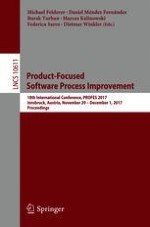2017 | OriginalPaper | Buchkapitel
Real-Life Challenges on Agile Software Product Lines in Automotive
verfasst von : Philipp Hohl, Jürgen Münch, Kurt Schneider, Michael Stupperich
Erschienen in: Product-Focused Software Process Improvement
Aktivieren Sie unsere intelligente Suche, um passende Fachinhalte oder Patente zu finden.
Wählen Sie Textabschnitte aus um mit Künstlicher Intelligenz passenden Patente zu finden. powered by
Markieren Sie Textabschnitte, um KI-gestützt weitere passende Inhalte zu finden. powered by
